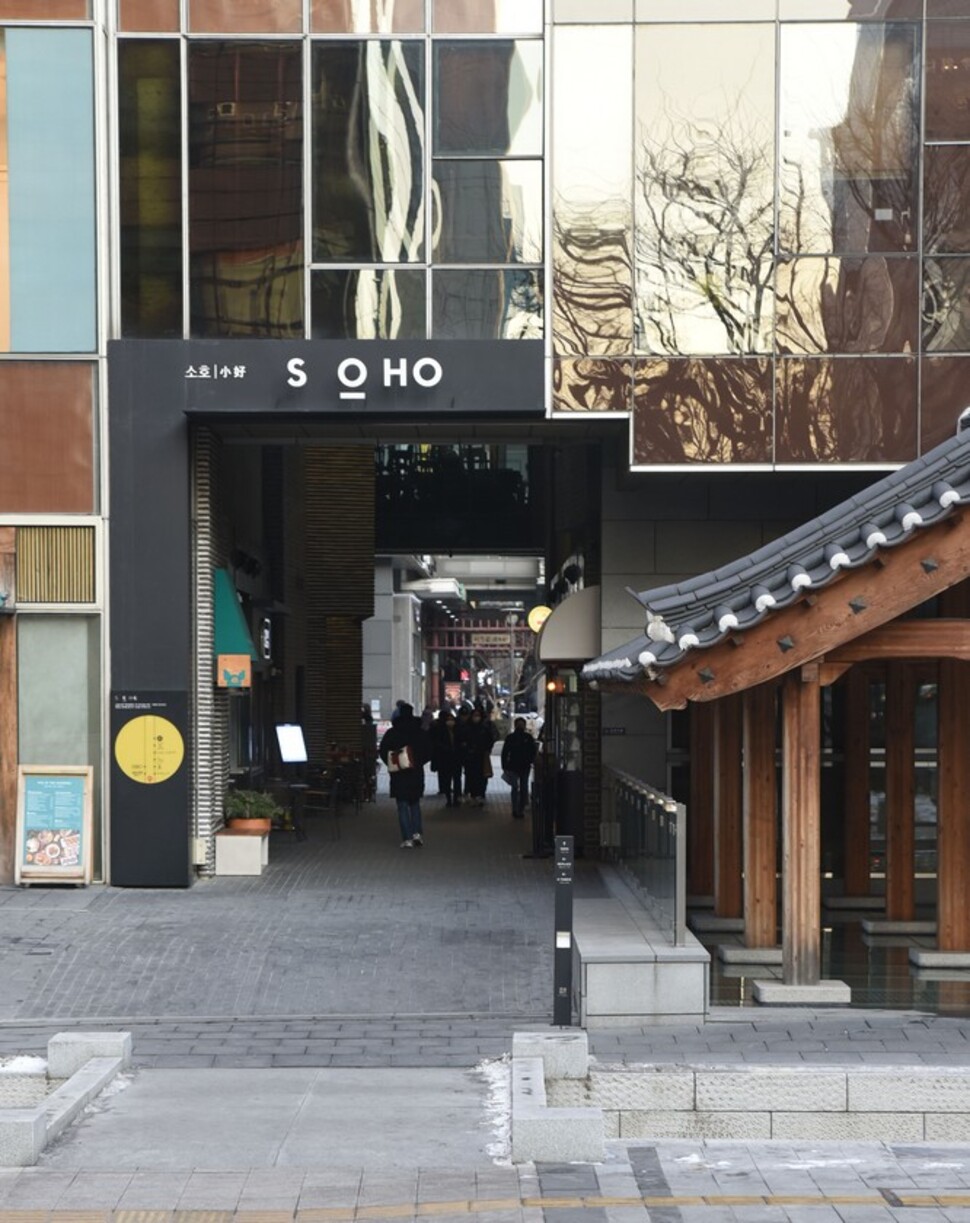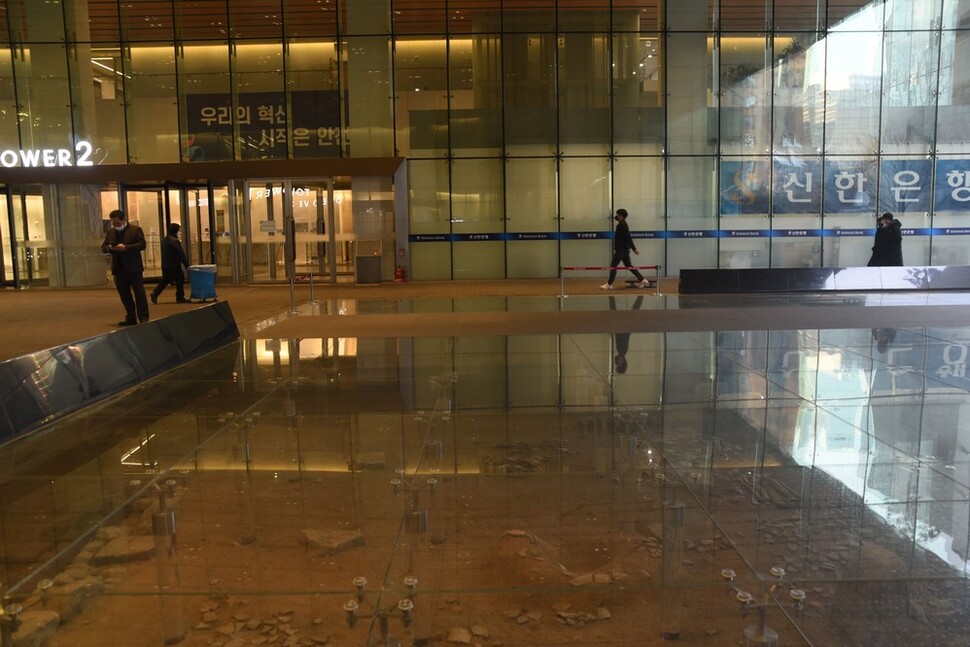[Jul] Downtown Seoul's Pimatgol preserved in new form
Date Jul 24, 2022
 The D-Tower entrance to Pimatgol, an alleyway favored by commoners during the Joseon Dynasty (1392-1910) that is now preserved inside four modern high-rises along Jong-ro. To the right, unearthed traces of that Dynasty are displayed under glass and a wooden pavilion with roof tiles.
The D-Tower entrance to Pimatgol, an alleyway favored by commoners during the Joseon Dynasty (1392-1910) that is now preserved inside four modern high-rises along Jong-ro. To the right, unearthed traces of that Dynasty are displayed under glass and a wooden pavilion with roof tiles.
In Korea’s race to become a developed country, a lot of heritage was left behind and forgotten. But traces of Korea’s past can still be found all over the place, even among the skyscrapers of downtown Seoul.
Pedestrians along the north side of Jong-ro, or Jongno, the main thoroughfare through the city center since ancient times, may notice any number of archaeological ruins that have been preserved and put on display. They may also follow a passage, running through the ground floors of four high-rises that stand side by side along Jong-ro. This corridor is lined with fast food and sit-down restaurants, coffee and ice cream shops – the kind of businesses that cater to foot traffic.
That passage is the result of a preservation attempt to save a centuries-old passage with a lot of heritage, though on the humble side. Pimatgol (literally, “Avoid-Horse Alley”) is its name, and it served as a shortcut as well as a refuge for the working classes.
During the 1392-1910 Joseon Dynasty, commoners found it time-consuming to travel along Jong-ro, as they would have to prostrate themselves before every aristocratic official passing by on horseback. Wishing to avoid this nuisance, they developed Pimatgol as a way to walk speedily right beside the city’s main street. A unique culture developed along this bustling footpath; in the 1990s and 2000s it manifested as a place for affordable nightlife.
With the area’s redevelopment, the need to preserve the passageway was recognized. Blueprints were changed, and when Le Meilleur Jongno Town opened in 2007, it included a ground-level passageway, right along the former Pimatgol route. Subsequently, three more buildings – D Tower, Tower 8 and Gran Seoul – introduced their own segments of Pimatgol, all connected in a row.
This new Pimatgol stretches for approximately 300 meters and is lined with shops and restaurants – just as in centuries past – albeit with significant upgrades.
Throughout the neighborhood, there are many preserved archaeological sites. Observant visitors may notice ruins on display here or there, sometimes protected under glass, sometimes embedded in a wall or also out in the open. Accompanying signs inform the curious about the history of the location.
Although most passersby don’t seem to pay attention, these sites are becoming more and more prevalent throughout the downtown core, leading to what some have dubbed the “Pompeii of Seoul.” But these ruins do not owe their existence to having been packed and stored away in volcanic ash.
Urban development was a lot different back in 1394 when Seoul became the capital of the newly established kingdom of Joseon. Rather than excavating to clear space for new buildings, the previous structures would simply be flattened, buried and built over. This process continued for centuries, accumulating a lot of unnaturally formed layers of dirt and debris. At the start of the modern era, new buildings were constructed atop all of this without any deep excavation, preserving those earlier ruins below the surface for decades longer.
Consequently, when ground is broken for new development projects around the old city center and advanced construction techniques are used that dig deep down, workers turn up a treasure trove of archaeological artifacts dating back over 600 years. Nowadays, whenever a redevelopment project is undertaken in this area, a thorough archaeological excavation must be carried out first. The findings are documented, preserved and often put back on display once the construction project is complete.
 Centuries-old ruins, which had been unearthed in an archaeological survey conducted prior to redevelopment, are on display under glass in front of the entrance to Gran Seoul, a high-rise office building on Jong-ro in downtown Seoul.
Centuries-old ruins, which had been unearthed in an archaeological survey conducted prior to redevelopment, are on display under glass in front of the entrance to Gran Seoul, a high-rise office building on Jong-ro in downtown Seoul.
This process has turned the four buildings connected through the new Pimatgol into a sort of living museum. Additionally, in Centropolis, a recently opened office building near Jonggak Station, Exit 3-1, visitors can ride an escalator down to layers from the 19th to 15th centuries housed in a whole museum dedicated to unearthed ruins on its B1 level. Interactive exhibits bring these former spaces to life, engaging people in activities such as placing roof tiles on a mock-up building, handling Joseon-era tools and taking a virtual reality tour through a traditional Korean house. The museum is free and has information posted in Korean and English throughout with brochures and guided tours also available in both languages as well as Chinese and Japanese.
That’s the paradox of downtown Seoul – as heritage disappears, it leads to the unearthing of other, even older heritage. As more of these heritage preservation sites pop up with each new construction project, Seoul will increasingly become known for its multi-layered history.
**If you have any questions about this article, feel free to contact us at kocis@korea.kr.**

The Ministry of Culture, Sports and Tourism's "Korea Here & Now" work can be used under the condition of "Public Nuri Type 1 (Source Indication)."




